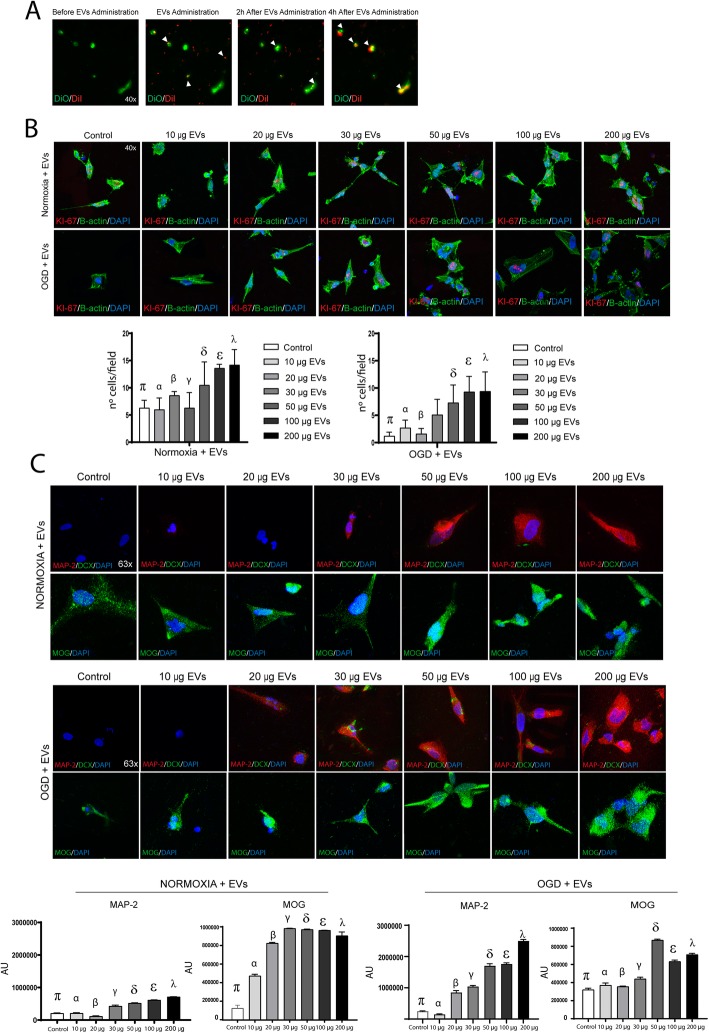Fig. 2.
In vitro assay. a Timelabs images of biodistribution of the EVs-DiI in neural stem cells-DiO subjected to OGD before, in the moment of EVs administration 2 h and 4 h after EVs administration. b Qualitative and quantitative images of cell proliferation of neural stem cells by Ki-67 staining under conditions of normoxia and OGD (n = 10 assays per group) (data are mean ± SD; for normoxia conditions p < 0.05: π = control vs. 100 μg and 200 μg; α = 10 μg, vs. 100 μg and 200 μg; β = 20 μg, vs. 100 μg and 200 μg; γ = 30 μg vs. 100 μg and 200 μg; δ = 50 μg vs. 10 μg and 30 μg; ε = 100 μg vs. control, 10 μg, 20 μg, and 30 μg; λ = 200 μg vs. control, 10 μg, 20 μg, and 30 μg. For OGD conditions, p < 0.05: π = control vs. 50 μg, 100 μg, and 200 μg; α = 10 μg, vs. 100 μg and 200 μg; β = 20 μg, vs 50 μg, 100 μg, and 200 μg; δ = 50 vs. control and 20 μg; ε = 100 vs. control, 10 μg and 20 μg; λ = 200 vs. control, 10 μg and 20 μg; 4′,6-diamidino-2-phenylindole (DAPI) is used for nuclear staining and B-actin for cytoplasm staining. Abbreviations: EVs, extracellular vesicles; OGD, oxygen and glucose deprivation. c Representative immunofluorescence images of neurons expressing MAP-2 and oligodendrocyte expressing MOG after receiving various doses of EVs under conditions of normoxia and OGD. 4′,6-diamidino-2-phenylindole (DAPI) was used for nuclear staining. Quantitative analysis of MAP-2 and MOG marker expression by immunofluorescence (n = 10 assays per group) (data are mean ± SD. For MAP-2 marker in normoxia conditions p < 0.05: π = control vs. 20 μg, 30 μg, 50 μg, 100 μg, and 200 μg; α = 10 μg, vs. 20 μg, 30 μg, 50 μg, 100 μg, and 200 μg; β = 20 μg, vs. all of groups; γ = 30 μg vs. all of groups; δ = 50 μg vs. all of groups; ε = 100 μg vs. all of groups; λ = 200 μg vs. all of groups. For MOG marker in normoxia conditions, p < 0.05: π = control vs. all of groups; α = 10 μg, vs. all of groups; β = 20 μg, vs. all of groups; γ = 30 μg vs. control, 10 μg; 20 μg; δ = 50 μg vs. control, 10 μg; 20 μg; ε = 100 μg vs. control, 10 μg; 20 μg; λ = 200 μg vs. control, 10 μg; 20 μg. For MAP-2 marker in OGD conditions, p < 0.05: π = control vs 50 μg, 100 μg, and 200 μg; α = 10 μg, vs. 20 μg, 30 μg, 50 μg, 100 μg, and 200 μg; β = 20 μg, vs 10 μg; 30 μg; 50 μg, 100 μg, and 200 μg; γ = 30 μg vs. 10 μg; 20 μg; 50 μg, 100 μg, and 200 μg; δ = 50 μg vs. control, 10 μg; 20 μg; 30 μg and 200 μg; ε = 100 μg vs. control, 10 μg; 20 μg, 30 μg, and 200 μg; λ = 200 μg vs. all of groups. For MOG marker in OGD conditions, p < 0.05: π = control vs. 30 μg, 50 μg, 100 μg, and 200 μg; α = 10 μg, vs. 30 μg, 50 μg, 100 μg, and 200 μg; β = 20 μg, vs. 30 μg, 50 μg, 100 μg, and 200 μg; γ = 30 μg vs. all of groups; δ = 50 μg vs. all of groups; ε = 100 μg vs. all of groups; λ = 200 μg vs. all of groups). Abbreviations: DCX, doublecortin; EVs, extracellular vesicles; MAP-2, microtubule associated protein 2; MOG, myelin oligodendrocyte glycoprotein; OGD, oxygen and glucose deprivation

